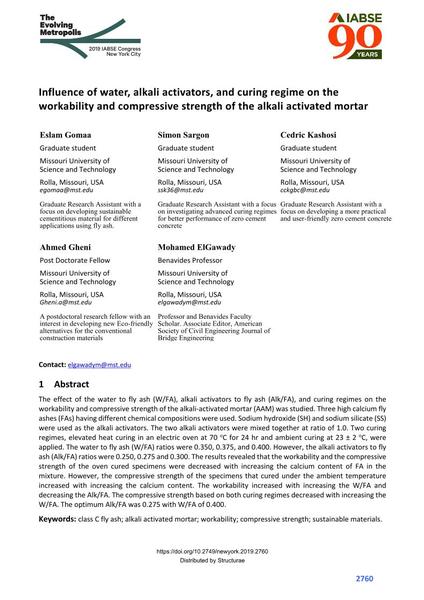Influence of water, alkali activators, and curing regime on the workability and compressive strength of the alkali activated mortar

|
|
|||||||||||
Bibliographic Details
| Author(s): |
Eslam Gomaa
(Missouri University of Science and Technology)
Simon Sargon (Missouri University of Science and Technology) Cedric Kashosi (Missouri University of Science and Technology) Ahmed Gheni (Missouri University of Science and Technology) Mohamed ElGawady |
||||
|---|---|---|---|---|---|
| Medium: | conference paper | ||||
| Language(s): | English | ||||
| Conference: | IABSE Congress: The Evolving Metropolis, New York, NY, USA, 4-6 September 2019 | ||||
| Published in: | The Evolving Metropolis | ||||
|
|||||
| Page(s): | 2760-2765 | ||||
| Total no. of pages: | 6 | ||||
| DOI: | 10.2749/newyork.2019.2760 | ||||
| Abstract: |
The effect of the water to fly ash (W/FA), alkali activators to fly ash (Alk/FA), and curing regimes on the workability and compressive strength of the alkali-activated mortar (AAM) was studied. Three high calcium fly ashes (FAs) having different chemical compositions were used. Sodium hydroxide (SH) and sodium silicate (SS) were used as the alkali activators. The two alkali activators were mixed together at ratio of 1.0. Two curing regimes, elevated heat curing in an electric oven at 70°C for 24 hr and ambient curing at 23 ± 2°C, were applied. The water to fly ash (W/FA) ratios were 0.350, 0.375, and 0.400. However, the alkali activators to fly ash (Alk/FA) ratios were 0.250, 0.275 and 0.300. The results revealed that the workability and the compressive strength of the oven cured specimens were decreased with increasing the calcium content of FA in the mixture. However, the compressive strength of the specimens that cured under the ambient temperature increased with increasing the calcium content. The workability increased with increasing the W/FA and decreasing the Alk/FA. The compressive strength based on both curing regimes decreased with increasing the W/FA. The optimum Alk/FA was 0.275 with W/FA of 0.400. |
||||
| Keywords: |
compressive strength class C fly ash alkali activated mortar workability sustainable materials
|
||||
